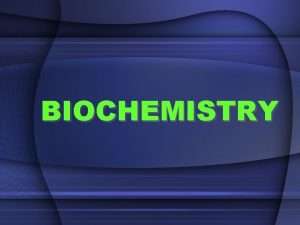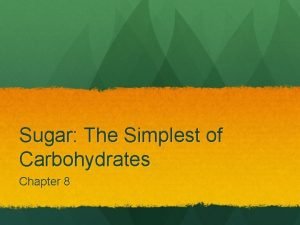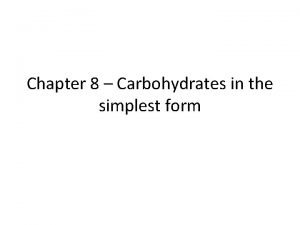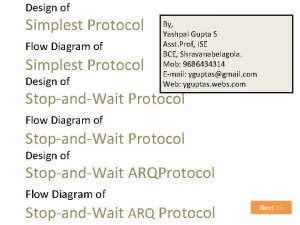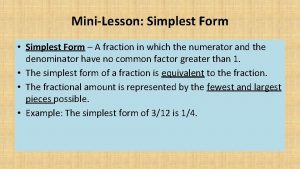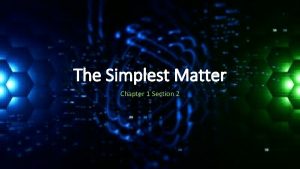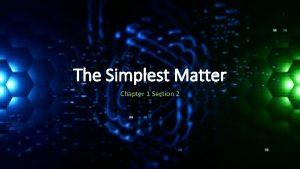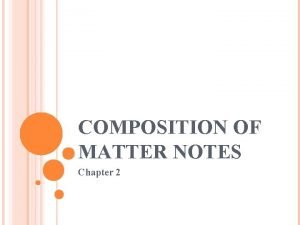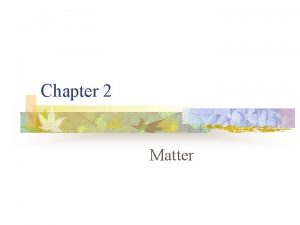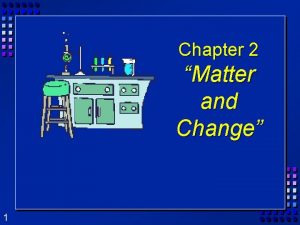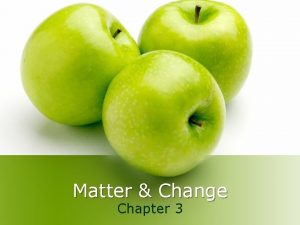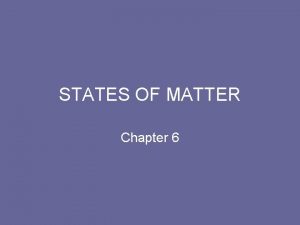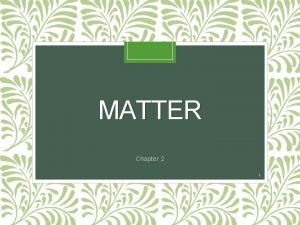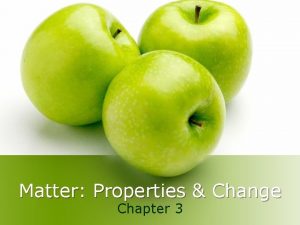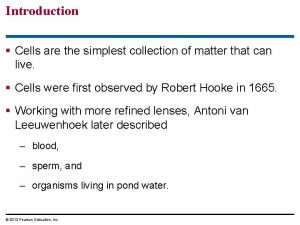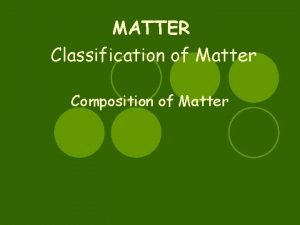Chapter 3 Section 2 The Simplest Matter 2



























- Slides: 27

Chapter 3 Section 2

The Simplest Matter 2 The Elements—One Kind of Atom • An element is matter made of only one kind of atom. • At least 118 elements are known and about 90 of them occur naturally on Earth. • Examples of naturally occurring elements include the oxygen and nitrogen in the air you breathe and the metals gold, silver, aluminum, and iron.

The Simplest Matter 2 The Elements—One Kind of Atom • The other elements are known as synthetic elements. • These elements have been made in nuclear reactions by scientists with machines called particle accelerators. • Some synthetic elements have important uses in medical testing and are found in smoke detectors and heart pacemaker batteries.

The Simplest Matter 2 The Periodic Table— Charting the Elements • Chemists have created a chart called the periodic table of the elements to help them organize and display the elements. • Each element is represented by a chemical symbol that contains one to three letters. • The symbols are a form of chemical shorthand.

The Simplest Matter 2 The Periodic Table— Charting the Elements

The Simplest Matter 2 The Periodic Table— Charting the Elements • The elements are organized on the periodic table by their properties. • There are rows and columns that represent relationships between the elements. • The rows in the table are called periods. • The elements in a row have the same number of energy levels.

The Simplest Matter 2 The Periodic Table— Charting the Elements • The columns are called groups. • The elements in each group have similar properties related to their structure. • They also tend to form similar bonds.

The Simplest Matter 2 Identifying Characteristics • Each element is different and has unique properties. • These differences can be described in part by looking at the relationships between the atomic particles in each element.

The Simplest Matter 2 Number of Protons and Neutrons • Cl is the symbol for chlorine. • The top number is the element’s atomic number.

The Simplest Matter 2 Number of Protons and Neutrons • It tells you the number of protons in the nucleus of each atom of that element. • Every atom of chlorine, for example, has 17 protons in its nucleus.

The Simplest Matter 2 Isotopes • Although the number of protons changes from element to element, every atom of the same element has the same number of protons. • However, the number of neutrons can vary even for one element. • These are called isotopes (I suh tohps), which are atoms of the same element that have different numbers of neutrons.

The Simplest Matter 2 Isotopes • An atom’s mass number is the number of protons plus the number of neutrons it contains. • Hydrogen has three isotopes with mass numbers of 1, 2, and 3.

The Simplest Matter 2 Isotopes • Each hydrogen atom always has one proton, but in each isotope the number of neutrons is different.

The Simplest Matter 2 Atomic Mass • The calculation of atomic mass takes into account the different isotopes of the element.

The Simplest Matter 2 Atomic Mass • About 76 percent of chlorine atoms are chlorine-35 and about 24 percent are chlorine -37. • The weighted average mass of all chlorine atoms is 35. 45 u.

The Simplest Matter 2 Atomic Mass • The atomic mass is the weighted average mass of the isotopes of an element. • The atomic mass is the number found below the element symbol. • The unit that scientists use for atomic mass is called the atomic mass unit, which is given the symbol u. • It is defined as 1/12 the mass of a carbon-12 atom.

The Simplest Matter 2 Classification of Elements • Elements fall into three general categories—metals, metalloids (ME tuh loydz), and nonmetals. • Metals generally have a shiny or metallic luster and are good conductors of heat and electricity. • All metals, except mercury, are solids at room temperature.

The Simplest Matter 2 Classification of Elements • Metals are malleable (MAL yuh bul), which means they can be bent and pounded into various shapes. • Metals are also ductile, which means they can be drawn into wires without breaking. • Most of the elements are metals.

The Simplest Matter 2 Other Elements • Nonmetals are elements that are usually dull in appearance. • Most are poor conductors of heat and electricity. • Many are gases at room temperature, and bromine is a liquid.

The Simplest Matter 2 Other Elements • The solid nonmetals are generally brittle, meaning they cannot change shape easily without breaking. • The nonmetals are essential to the chemicals of life. • More than 97 percent of your body is made up of various nonmetals. • Except for hydrogen, the nonmetals are found on the right side of the periodic table.

The Simplest Matter 2 Other Elements • Metalloids are elements that have characteristics of metals and nonmetals. • All metalloids are solids at room temperature. • Some metalloids are shiny and many are conductors, but they are not as good at conducting heat and electricity as metals are.

Section Check 2 Question 1 What is the term for matter composed of only a single kind of atom? A. compound B. element C. mixture D. substance

Section Check 2 Answer The correct answer is B. Gold is an example of an element.

Section Check 2 Question 2 What is the name of the chart, composed by chemists, that arranges all the known elements, their properties, and their symbols?

Section Check 2 Answer The chart is known as the periodic table.

Section Check 2 Question 3 Every atom of the same element has the same number of protons. However, a given atom may have more neutrons than another atom of the same element. Atoms of an element with different numbers of neutrons are known as _______?

Section Check 2 Answer The answer is isotopes. Chlorine-35 and chlorine-37 are examples of isotopes.
 Chapter 2 matter section 1 classifying matter answer key
Chapter 2 matter section 1 classifying matter answer key What is the simplest form of a substance
What is the simplest form of a substance Section 1 composition of matter
Section 1 composition of matter Classification of matter section 1 composition of matter
Classification of matter section 1 composition of matter Section 1 composition of matter
Section 1 composition of matter Chapter 8 sugar: the simplest of carbohydrates
Chapter 8 sugar: the simplest of carbohydrates Carbohydrates simple form
Carbohydrates simple form Chapter 10 review states of matter section 4
Chapter 10 review states of matter section 4 Chapter 2 principles of ecology answers
Chapter 2 principles of ecology answers Whats gray matter
Whats gray matter Gyrus and sulcus function
Gyrus and sulcus function Gray matter and white matter
Gray matter and white matter Frontal and parietal lobes
Frontal and parietal lobes Flow of energy vs flow of matter
Flow of energy vs flow of matter Chapter 10 section 1 meiosis answer key
Chapter 10 section 1 meiosis answer key Hát kết hợp bộ gõ cơ thể
Hát kết hợp bộ gõ cơ thể Lp html
Lp html Bổ thể
Bổ thể Tỉ lệ cơ thể trẻ em
Tỉ lệ cơ thể trẻ em Gấu đi như thế nào
Gấu đi như thế nào Tư thế worm breton là gì
Tư thế worm breton là gì Chúa sống lại
Chúa sống lại Kể tên các môn thể thao
Kể tên các môn thể thao Thế nào là hệ số cao nhất
Thế nào là hệ số cao nhất Các châu lục và đại dương trên thế giới
Các châu lục và đại dương trên thế giới Công của trọng lực
Công của trọng lực Trời xanh đây là của chúng ta thể thơ
Trời xanh đây là của chúng ta thể thơ Mật thư anh em như thể tay chân
Mật thư anh em như thể tay chân

